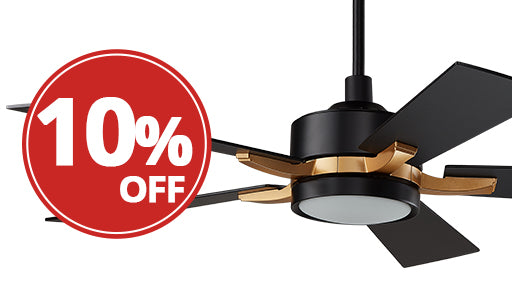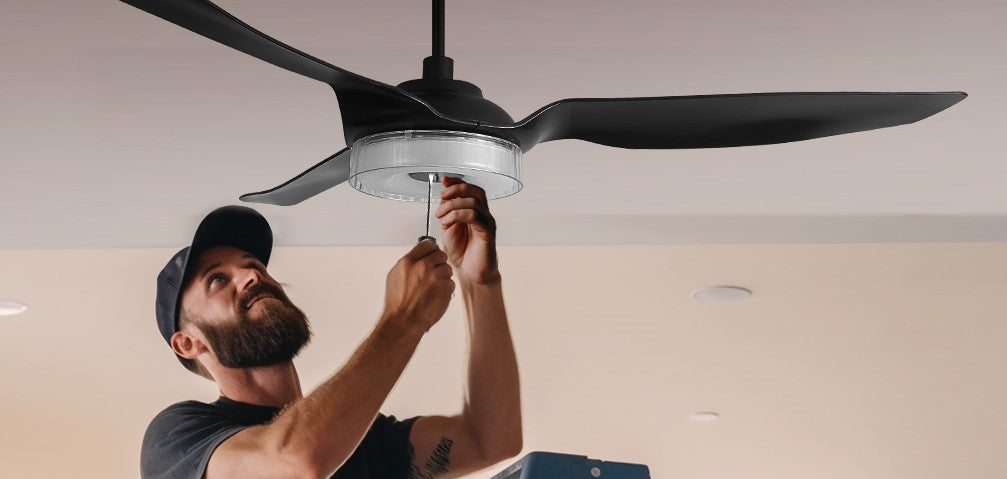A noisy ceiling fan can be extremely bothersome, disrupting your peace and tranquility. It's crucial to identify the type of noise your fan is making in order to troubleshoot and address the problem effectively. Whether it's clicking, humming, buzzing, or another type of noise, understanding the cause is key to finding the right solution.
This guide helps you understand fan noises, why they happen, and how to fix them. Follow these steps to make your home's noisy ceiling fan quiet and peaceful.
Types of Ceiling Fan Noise
There are several types of ceiling fan noise sounds, each with unique characteristics. Identifying the type of noise your fan is making is the first step in diagnosing and fixing the problem.
Clicking Noise
A clicking noise is one of the most common noises a fan can make. It is often a result of a loose part. If the clicking noise is consistent, it might indicate a problem with the blades. On the other hand, if the clicking noise is irregular, it could be a sign of a loose light fixture.
Humming or Buzzing
A humming or buzzing noise is usually a sign of an electrical issue. A humming or buzzing noise from your ceiling fan could indicate a problem with the motor or wiring. Investigate the issue to determine the cause. It's important to fix it right away to avoid any electrical dangers.
Rubbing Noise
A rubbing noise often indicates a mechanical issue. It's usually caused by parts of the fan rubbing against each other. This could be a result of misalignment or insufficient lubrication.
Crackling or Sizzling Noise
A crackling or sizzling sound is a serious issue that needs immediate attention. It's often a sign of an electrical problem that can lead to a fire if not addressed promptly.
Causes of a Noisy Ceiling Fan
Now that you understand the different types of fan noises let's delve into their causes. A noisy ceiling fan is often a result of mechanical or electrical issues.
A clicking noise from your ceiling fan could be caused by a few things. These include a loose blade, a bent blade arm, or a loose light fixture. If it hums or buzzes, it could be a problem with the motor or wiring.
A rubbing noise often indicates that parts of the fan are rubbing against each other. This could be due to misalignment or insufficient lubrication. Lastly, a crackling or sizzling sound is often a sign of an electrical problem and needs to be addressed immediately.
How to Fix a Ceiling Fan That Makes Clicking Noises

A ceiling fan making clicking noises can be quite annoying. However, with a little patience and the right tools, you can fix it.
Diagnose a Clicking Noise Ceiling Fan
The first step in fixing a clicking ceiling fan is diagnosing the problem. Start by following these steps:
- Switch off the fan: Begin by turning off the fan to ensure safety during inspection and repair.
- If your ceiling fan has a light, remove it. Check if the light and fan are rubbing or not connected properly. Sometimes, improper contact between the light fixture and the fan can cause clicking noises.
- Inspect the blades: Carefully examine the fan blades for any signs of damage, irregularities, or looseness. Look for bends, cracks, or loose blades, as these issues can contribute to the clicking noise.
- Check the blade arms: If you notice blade damage, inspect the fan's blade arms for any deformations. A deformed bracket can cause the blades to rub against it, resulting in clicking sounds.
- To check if the blades of a fan are causing a clicking noise, take them off and turn on the fan. If the noise is still there, the problem is not with the blades.
Remember to always turn off the fan's power switch before performing any inspections or repairs to ensure safety. If you're uncertain about the problem.
Resolving the Clicking Noise
Once you've identified the cause of the ceiling fan clicking noise, you can fix it.
If the problem is a loose blade, tighten it using a screwdriver.
If the blade arm is bent or misaligned, you might need to replace it.
If the light fixture is loose, tighten it securely.
If you notice any scratches or damage on the blade bracket and the noise disappears after removing the blade arm to inspect, it is possible that the housing is making contact with the motor. In such a case, you will need to adjust the position of the motor housing accordingly.
Fix a wobbly ceiling fan by balancing the blades to stop the noise. Details see how to fix a wobbly ceiling fan.
If these solutions don't work, you might need to consider contacing the customer service and replacing the entire fan.
Handle a Buzzing Noises Ceiling Fan
If your Carro ceiling fan is making a buzzing noise, try tightening the screws and cleaning it. Make sure it's mounted correctly. If the noise continues, ask customer support for help or hire an electrician to check it.
Dealing with a Ceiling Fan That's Humming
If your Carro fan is humming, it might be due to a problem with the motor or the wiring. Start by inspecting the motor. If it's overheating, it could be causing the humming noise.
Next, check the wiring. If it's loose or damaged, it could be causing the humming noise. If you're not confident about dealing with electrical issues, it's best to call a professional.
Fix Rubbing Noise
If you are experiencing a rubbing noise from your ceiling fan, it is important to address the issue to restore its smooth and quiet operation. One common cause of this noise is the canopy rubbing against other components.
To address the rubbing noise issue caused by the canopy:
- Turn off the fan and power supply.
- Check the canopy for any areas rubbing against other components.
- Adjust the position of the canopy to eliminate contact with other parts.
- Turn on the fan and observe if the rubbing noise has been resolved.
- If the sound continues, it may be wise to seek help from a professional or reach out to the manufacturer for additional advice.
Tips to Prevent Ceiling Fan Noises in the Future
To prevent ceiling fan noises in the future, it's important to maintain your fan regularly. This includes cleaning the blades regularly, tightening loose parts, and lubricating moving parts.
Additionally, ensure that the fan is correctly installed. An improperly installed fan is more likely to develop noises over time. Lastly, if you notice any noise, address it immediately instead of waiting for it to get worse.
When to Call a Professional for Your Noisy Ceiling Fan
While it's possible to fix some ceiling fan noises yourself, there are instances when you need to call a professional. If you're experiencing electrical issues causing noise, it may be time to seek help. You should seek assistance if you don't feel confident in fixing the problem. If your attempts to fix the problem have not been successful, you should contact a professional.
A professional has the skills and experience to diagnose and fix problems effectively. They can also provide advice on how to prevent such noises in the future.
Conclusion

A noisy ceiling fan can be quite a nuisance. However, by understanding the different types of fan noises and their causes, you can diagnose and fix the problem effectively. There's always a solution, whether your fan is clicking, humming, or buzzing.
Remember, regular maintenance can go a long way in preventing fan noises. However, if you're not comfortable dealing with the problem or the noise persists despite your efforts, don't hesitate to call a professional. With the right approach, you can enjoy a quiet and efficient ceiling fan in your home.















